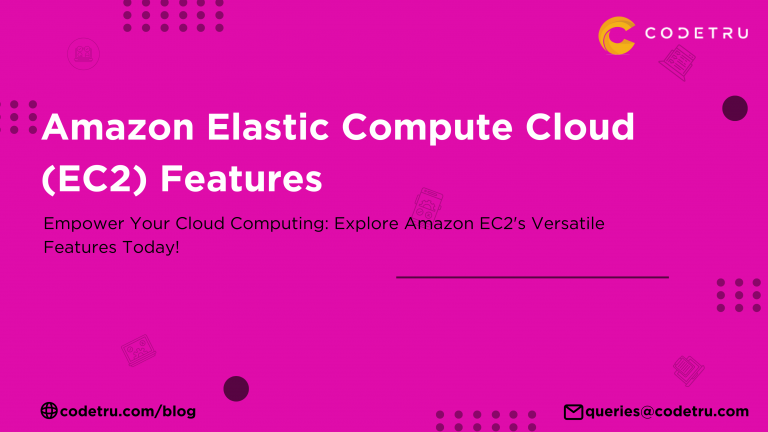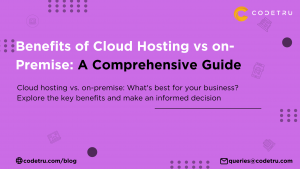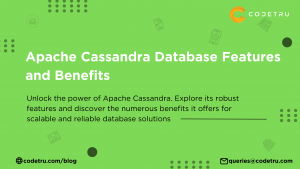A system that provides the computing capacity that is scalable in AWS cloud. This is used to launch virtual servers as per your requirement monitor and configure its security settings and networking and manage the storage.
Let’s Understand the Functionality of Amazon Elastic Compute Cloud (Amazon EC2).
Amazon EC2 offers an imaginary computing space that allows a user to use the web service interface according to his needs. This functionality enables users with many operating system options with customized application environment to help manage network’s access permissions run the image using many systems of their choice.
How to Use Amazon EC2
Operation Amazon EC2 is easier than you think. You need to Select a pre-configured template known as Amazon Machine Image (AMI) . This will help you get on your feet instantly containing your applications, libraries, data, and associated configuration settings. On your Amazon EC2 instance now it is time to configure security and network access.
Once you decide on the instance type that you need, you can then start, monitor and end as many instances of your AMI as need. This can obtained using the web service APIS or from the variety of management tools available
If you decide to run this instance in different locations, you can make use of static IP end points or add a resolute block storages. Based on number of instance-hours or the data transfers you can pay only for the resources that you have actually utilized.
Features of Amazon EC2
Amazon EC2 offers various extra ordinary features that help in building accessible, failure resilient, and business class applications.
Bare Metal instances
With straight access to the processor and memory of the underlying server Amazon EC2 bare metal instances are perfect choice for your undue workloads that requires access to various hardware feature sets or for applications that run in non-virtualized environments for licensing or support requirements. Bare metal instances are built on the Nitro system, which is a collection of AWS-built hardware offload and hardware protection components that come together to securely provide high performance networking and storage resources to EC2 instances.
Bare metal instances offer the same robust security, reliability, capacity, elasticity and support for different operating systems and software packages as other virtual EC2 instances. You can also use bare metal instances with AWS services such as Amazon Virtual Private Cloud (VPC), Elastic Block Store (EBS), Elastic Load Balancing (ELB) and more.
Optimize Compute Performance and Cost with Amazon EC2 Fleet
Amazon EC2 Fleet aids you with the flexibility of compute capacity across EC2 instance types, Availability Zones, and purchase models to help optimize scale, performance and cost with a single API call. With this you can define how much on-demand and spot capacity to launch through this EC2 fleet.
You can also specify the type of instance that you prefer and its scale capacity based on cores, memory and instances. You can access EC2 fleet capabilities through Amazon EC2 auto scaling to to provision and automatically scale compute capacity across EC2 instance types, Availability Zones, and purchase options in a single Auto Scaling Group.
Pause and Resume Your Instances
This is an amazing feature where you can pause or stop your Amazon EC2 instances that are backed by Amazon EBS and start again from the state that you had paused. The feature can benefit applications that would take a longer time to bootstrap and persist state into memory (RAM). Hibernation gives you all the benefits of Stop and Start, and additionally, data from memory (RAM) is also persisted between sessions. You will not be charged for instance usage while your instance is hibernated. Storage is charged at standard EBS rates.
GPU Compute Instances
Customers requiring massive floating point processing power will benefit from the next-generation of general-purpose GPU compute instances from AWS, Amazon EC2 P3 instances with up to 8 NVIDIA® V100 Tensor Core GPUs. P3 instances provide up to 1 petaFLOPS of mixed-precision, 125 teraFLOPS of single-precision and 62 teraFLOPS of double-precision floating point performance.
A 300 GB/s second-generation NVLink interconnect allows GPU-to-GPU communication at high speed and low latency. P3 instances also feature up to 96 vCPUs based on custom Intel processors, 768 GB of DRAM, and 100 Gbps of dedicated aggregate network bandwidth using the Elastic Network Adapter (ENA). P3 instances are ideally suited for machine learning, high-performance computing, computational fluid dynamics, computational finance, seismic analysis, molecular modeling, genomics, and rendering workloads.
GPU Graphics Instances
Customers requiring high graphics capability will benefit from GPU graphics instances. The current generation GPU graphics instance, G3 instance, provides access to NVIDIA Tesla M60 GPUs, each with up to 2,048 parallel processing cores, 8 GiB of GPU memory, and a hardware encoder supporting up to 10 H.265 (HEVC) 1080p30 streams and up to 18 H.264 80p30 streams. With the latest driver releases, these GPUs provide support for OpenGL, DirectX, CUDA, OpenCL, and Capture SDK (formerly known as GRID SDK). GPU graphics instances are ideally suited for 3D visualizations, graphics-intensive remote workstations, 3D rendering, application streaming, video encoding, and other server-side graphics workloads.
High I/O Instances: Customers requiring very high, low latency, random I/O access to their data can benefit from High I/O instances. High I/O instances are an Amazon EC2 instance type that can provide customers with random I/O rates over 3 million IOPS.
High I/O I3 and I3en instances are backed by Non-Volatile Memory Express (NVMe) based SSDs, and are ideally suited for customers running very high-performance NoSQL databases, transactional systems, and Elastic Search workloads. High I/O instances also offer sequential disk throughput of up to 16 GB/s, which is ideal for analytics workloads.
Frequently Asked Questions About Amazon EC2
1. What is Amazon EC2 and how does it work?
Amazon EC2 (Elastic Compute Cloud) is a scalable cloud computing service offered by AWS that allows users to launch and manage virtual servers as needed. It provides customizable computing capacity in the cloud, enabling users to select pre-configured templates (Amazon Machine Images) to get started quickly and configure security, networking, and storage settings according to their requirements.
2. What are some of the key AWS EC2 features that enhance its usability?
AWS EC2 offers several key features that enhance its usability, including Bare Metal instances for direct access to hardware, Amazon EC2 Fleet for optimizing compute performance and cost, GPU Compute Instances for high-performance computing, Hibernation for pausing and resuming instances, and High I/O Instances for low latency and high IOPS requirements. These features make AWS EC2 a flexible and powerful choice for various computing needs.
3. What are the benefits of using Amazon EC2 for my applications?
Amazon EC2 offers several benefits, including scalability, flexibility, and cost optimization. Users can scale computing resources up or down based on demand, choose from various instance types to suit their needs, and only pay for the resources they use. Additionally, EC2 integrates seamlessly with other AWS services, such as Amazon VPC, EBS, and ELB, enhancing overall application performance and reliability.
4. How does Amazon EC2 handle high-performance computing (HPC) needs?
Amazon EC2 provides specialized instances for high-performance computing, such as GPU Compute Instances and High I/O Instances. GPU Compute Instances, like P3 instances, offer powerful GPUs for tasks requiring massive floating-point processing power, ideal for machine learning and scientific computing. High I/O Instances, like I3 and I3en, are designed for high-performance NoSQL databases and transactional systems, offering high IOPS and low latency.
5. Can I pause and resume my Amazon EC2 instances?
Yes, Amazon EC2 allows you to pause and resume instances using the Hibernation feature. When you pause (hibernate) an instance, the data in memory (RAM) is saved, and you can restart the instance later from the same state. This feature is useful for applications that take a long time to bootstrap or require persistent memory states. You are not charged for instance usage while it is hibernated, but storage is charged at standard EBS rates.







